By Thomas Beeston
European high-yield bond issuance is set for the lowest first-half total since the global financial crisis, as volatile interest rates and fears over rising inflation forced investors to assess the impact of a global recession on the asset class.
LCD data shows just €4.5 billion of European high-yield paper was sold via public syndication in the second quarter (to June 24), which is the lowest tally on a quarterly basis since the second quarter of 2012, and well under half the €10.8 billion issued in the first quarter. Meanwhile, first-half issuance of €15.3 billion is the lowest on that measure since a €4.4 billion print in the first half of 2009 as markets reacted to the GFC, according to LCD data.
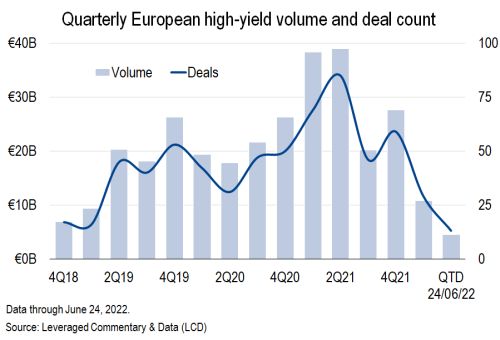
Fears over inflation and rising interest rates were exacerbated by the war in Ukraine, which triggered a 10-week closure of the primary market starting in February. What began as trepidation around execution risk snowballed into a broader upheaval amid changing interest-rate expectations, triggering outflows of 15.6% of assets under management in the European high-yield asset class as of June 20, according to Spread Research. This dynamic left leveraged deals reliant on CLOs and private capital demand, as real-money investors increasingly sat on the sidelines due to concerns over rising inflation and fund outflows, while double-B names have been put off by volatility caused by sharp moves in government bond yields.
Pricing reference
Towards the end of May, bonds did find a stable pricing reference for defensive double-B names as French outsourcing group Elis, rated BB+/Ba2, which reopened the market in eye-catching style with a €300 million five-year unsecured tranche that priced at 4.25%. Orders closed in excess of €3 billion, underlining pent-up demand for defensive credit and the continued presence of investment-grade accounts in high yield — especially as a BBB rating at DBRS made the credit eligible for the ECB’s corporate sector purchase programme. Volvo Car and Huhtamaki soon followed, with similar €500 million five-year bonds that both priced at 4.375% and with books 2.4x and 3x oversubscribed, respectively, again indicating both a stable pricing point and pool of demand.
This part of the market however effectively closed on the week of the ECB’s June 9 policy meeting, which alongside U.S. CPI data on June 10, triggered a huge sell-off in rates. The 10-year Bund yield hit 1.42% in the aftermath of the ECB’s hawkish policy statement, before reaching a new 10-year high of 1.76%, while the trend in credit saw increasing pressure in the CDS market and a growing dislocation between double-B and lower-rated credit.
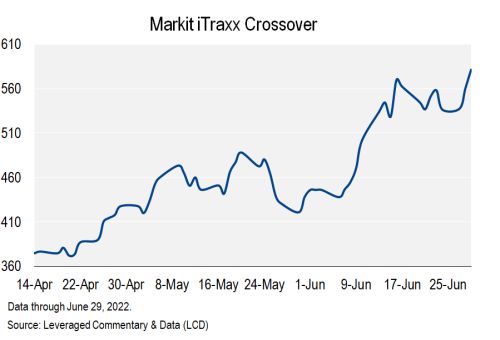
“What is clear for high yield is that people will need to think about yields and not just spreads. Given the dramatic Bund move, the all-in cost for borrowers is not just wider spreads, but much higher base rates,” said a high-yield fund manager. In June, average single-B yields in the European secondary market ballooned 8.4% according to Spread Research (based on research published June 20), while double-B yields have risen to 6% since the trio of deals in late May and early June. The move at the lowest end of the ratings spectrum was even starker, with the CCC yield quoted at 11.7% by Spread Research in the same piece.
For lower-rated deals the market has never really found a stable footing because there has rarely been a sustained period of calm to run a five-day bookbuild, while the single-B yield has risen more sharply than the better-rated cohorts, and the few deals which did have to come were all underwritten for very different market conditions. “There is not a great deal of demand generally for single-B risk, which reflects the view that its relationship with double-B credit can widen further, especially as the macro picture worsens,” said another high-yield fund manager.
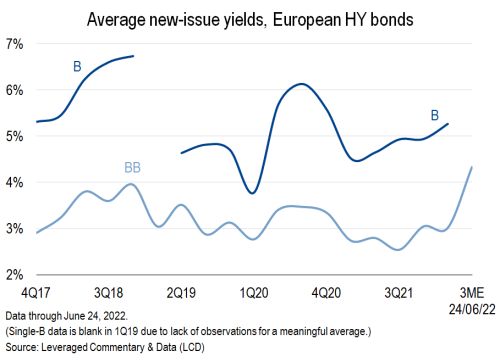
With all European high-yield deals issued since Russia’s invasion of Ukraine having traded well underwater despite attractive new-issue discounts from borrowers such as Miller Homes, La Liga and Biofarma — coupled with a lack of a clear view on when inflation and interest rates will really reach a limit — investors still do not have a pricing point for single-B risk, and in June demanded double-digit yields for this ratings category.
But even then, a lack of liquidity in the secondary market means that few deals have performed well on the break. “On a 12-18 month look back, these will be good trades and you should make your 10% p.a., but on a 3-6 month horizon I think the entry point is better,” said one trading source, noting that recessionary concerns are still not fully priced in to credit and rates.
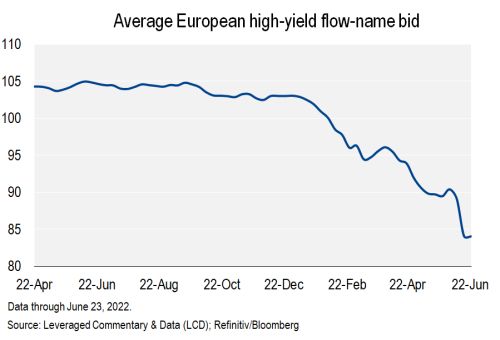
Unattractive and unsustainable
This dynamic lessens the appeal from the point of view of fast-money buyers, while real-money investors are left with a clear dilemma as to how sustainable it is to be saddling firms with double-digit interest costs at a time when analysts are beginning to reassess their default expectations. “When you start talking about double-digit yields, you worry about interest coverage,” said an investor at a global bond fund. “Deals have come with large OIDs to compensate for that and as an investor it gives you better convexity, but it is still the case from an issuer's perspective that you only go in this market unless you absolutely have to.”
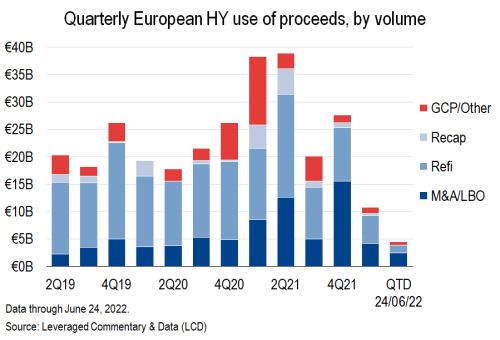
Bigger discounts
In a trend established with buyout trades for Miller Homes, Biofarma and LaLiga, deals in the single-B space in June landed at increasingly bigger discounts, and in most cases wide of where they were first pitched. For example, Swedish oil refiner Preem priced €340 million of 12% notes at a discount of 96 for a yield of roughly 13.1%, in a deal which marked the second-highest yield ever paid in the unsecured euro high-yield space, according to LCD data. Lone Star meanwhile priced a €350 million 7.25% five-year secured note to finance its acquisition of Manuchar at 86 for a yield of 10.948%, in what marked the largest discount in the high-yield space in more than 10 years.
Meanwhile, London-listed gaming group 888 was at the end of June in the process of marketing a financing package worth roughly £1.02 billion-equivalent, set to be sold across five-year fixed-rate notes, a six-year floating-rate tranche and a $500 million term loan. The deal marks the culmination of many months of interaction with investors, with the debt package having been initially underwritten in September 2021. Investors here are expecting a yield of 10% or above, according to market sources, in what looks like another attempt to draw in risk-averse investors.
“The current generous pricing in some deals currently in the high yield market is fine if we assume the default rate will remain below the historical average of 4% over the next two years,” Sergio Grasso, director at iason, wrote in a June 28 report. “It is still not enough, if the current and future restrictive monetary policies will tilt the economies into recession.”
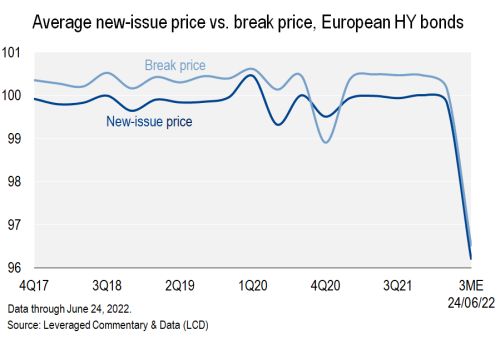
The €545 million 4.75% secured bond for Morrisons was reported to have landed at an even deeper discount of 85 when it priced privately in late May, indicating a yield of roughly 8.5% for the five-year notes. Like the £1.2 billion sterling issue it completed in April, this deal does not appear in LCD's data because it was placed entirely with private investors.
Blurring boundaries
But this was far from the only deal which blurred boundaries between the public and private markets. Preem for example placed its five-year offering with a small group of investors after roughly a month of pre-marketing, with the deal only made public the day after it priced on June 14. Similarly, Manuchar included a €75 million commitment placed with an anchor account prior to the bond launch, although the bonds were said to have been up-to-80% covered prior to the public announcement of the deal, according to buyside sources. Still, the deal priced at the wide end of 86-87.5 guidance.
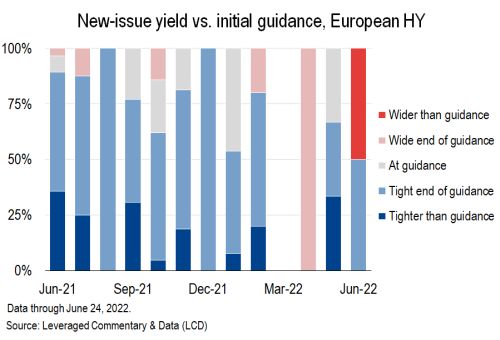
“If pricing is wide enough to bring in private funds, then a combination of public and private makes sense,” said another head of leveraged finance. “They still have money to invest whereas regular loan players don’t, which is why we will see others adopt a hybrid approach.”































































































